MICROSCOPY ON STAMPS
by Dave Walker
This is an image intensive article,
downloading may take some time!
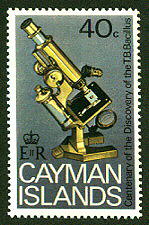
There's a fascinating variety of microscopes, photomicrographs
and microbiologists depicted on stamps. The author would not describe himself
as a philatelist but here's a few thoughts on how to collect microscopy
related stamps with references to more detailed illustrated articles. To
whet your appetite some of the author's favourite stamps depicting microscopes
are shown.
Rekindling an interest
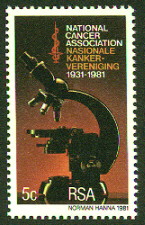
In 1989 the Royal Microscopical Society celebrated their
150th anniversary and the Post Office issued an attractive set of four
stamps on this theme showing photomicrographs. As well as the PO's presentation
pack of these stamps, there were a variety of attractive first day covers
issued (see below) where the envelope illustrated old and new microscopes.
Like many microscopists I bought a few of these, and this rekindled a latent
interest in stamps that had been dormant since the days I collected them
rather haphazardly as a youngster.
An inefficient way of collecting them ...
So, knowing nothing of philately, I began to wonder how
many stamps had been published with microscopy as a theme. As a start I
went back to my old stamp album gathering dust in a loft and found two
stamps with a microscope on .... wow, I had the start of a collection!
I even bought a stamp magazine and found a few dealers who had thematic
catalogues of stamps. Catalogues of medical stamps seemed a good place
to start browsing. However, I rapidly found that ordering sets such as
those celebrating the World Health Organisation or the discovery of the
tubercle bacillus hoping they may illustrate a microscope, was a rather
laborious way of collecting them! Having said that, dealers catalogues
do usually mention when microscopes form a major part of the stamp.
.... a much better way to collect
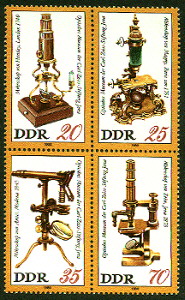 I thought there must be a better way to collect than this, so a trip to
my local university library in late 1990 had me browsing through microscopy
journals to see if anyone had catalogued them. Fortunately, I didn't have
to look far. The Proceedings of the RMS had published a superb series of
articles earlier in 1990 by William Wergin on this very topic. The articles
had a complete list of stamps issued world-wide which depicted a microscope
in some shape or form, and were illustrated by colour plates of many of
these stamps. The colour plates showed the different themes for which a
microscope illustration has been used on stamps. This varies from the celebration
of famous discoveries such as Koch's isolation of the tubercle bacillus,
health topics such as malaria eradication and scientific endeavour.
I thought there must be a better way to collect than this, so a trip to
my local university library in late 1990 had me browsing through microscopy
journals to see if anyone had catalogued them. Fortunately, I didn't have
to look far. The Proceedings of the RMS had published a superb series of
articles earlier in 1990 by William Wergin on this very topic. The articles
had a complete list of stamps issued world-wide which depicted a microscope
in some shape or form, and were illustrated by colour plates of many of
these stamps. The colour plates showed the different themes for which a
microscope illustration has been used on stamps. This varies from the celebration
of famous discoveries such as Koch's isolation of the tubercle bacillus,
health topics such as malaria eradication and scientific endeavour.
Click here
to view a larger image of the stamp group right.
Most countries in the world seem to have issued at least
one stamp depicting a microscope, although a country conspicuous by its
absence in the list to August 1990 seems to be the author's home i.e. the
UK. This seems a pity when some of the finer stamps issued by other countries
depicting microscopes are associated with British scientists e.g. Fleming
and Darwin.
What surprised me, was how many stamps had been issued
illustrating microscopes, almost 400 up to August 1990. This was a rather
daunting number for me to attempt to collect myself, not to mention expensive.
So I decided to just collect the stamps with the finer illustrations of
microscopes old and new plus any first day covers I came across.
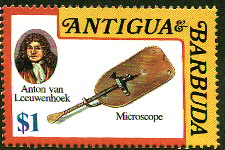 Many of the stamps depicting microscopes used stylised microscopes or the
microscope did not form a good proportion of the illustration. My collection
to date is still very modest, just fifty or so, but when they are nicely
mounted in an album with the first day covers they are an attractive way
of illustrating the history of microscopes and microbiology. Part of the
fun of collecting is tracking down the more elusive stamps. I just regularly
glance through thematic catalogues to see if the ones I'm looking for have
turned up. This is made easier as some of the larger dealers are now putting
their catalogues on-line.
Many of the stamps depicting microscopes used stylised microscopes or the
microscope did not form a good proportion of the illustration. My collection
to date is still very modest, just fifty or so, but when they are nicely
mounted in an album with the first day covers they are an attractive way
of illustrating the history of microscopes and microbiology. Part of the
fun of collecting is tracking down the more elusive stamps. I just regularly
glance through thematic catalogues to see if the ones I'm looking for have
turned up. This is made easier as some of the larger dealers are now putting
their catalogues on-line.
One of the pleasures of collecting stamps related to a
hobby like microscopy, is that it broadens your knowledge of the subject.
It's quite a challenge to identify and learn more about some of the anonymous
microscopes depicted in the illustrations, and some of the scientists commemorated
were also unfamiliar to me. This often prompts a search to find out the
scientist's contribution to, or use of, microscopy. Not surprisingly Koch
and Pasteur are well represented on these type of stamps, but you may (like
me) have to reach for a textbook to find out why for example Nansen, Cajal,
Klug, Bruce and Zammit are illustrated on stamps with microscopes. As an
aside, the first stamp ever issued depicting a microscope is believed to
be that issued in Spain 1934 and shows Ramon y Cajal.
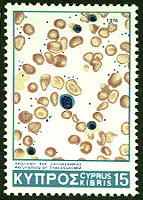 If you don't fancy collecting all 400 plus of the stamps depicting microscopes
plus the new ones regularly issued, there are various narrower themes that
you may wish to choose. For example, electron microscopes are only infrequently
illustrated on stamps issued to August 1990. Photomicrographs of a specific
topic e.g. protozoa or microbiology are another group of potential interest
although I'm uncertain of the number issued. The image left shows an attractive
photomicrograph of blood cells. The stamp set celebrating the RMS 150th
anniversary also chose a theme of photomicrographs, and there are some
very attractive first day covers including this set of stamps. A typical
one is shown below, the microscope by George Adams is printed on silk.
If you don't fancy collecting all 400 plus of the stamps depicting microscopes
plus the new ones regularly issued, there are various narrower themes that
you may wish to choose. For example, electron microscopes are only infrequently
illustrated on stamps issued to August 1990. Photomicrographs of a specific
topic e.g. protozoa or microbiology are another group of potential interest
although I'm uncertain of the number issued. The image left shows an attractive
photomicrograph of blood cells. The stamp set celebrating the RMS 150th
anniversary also chose a theme of photomicrographs, and there are some
very attractive first day covers including this set of stamps. A typical
one is shown below, the microscope by George Adams is printed on silk.
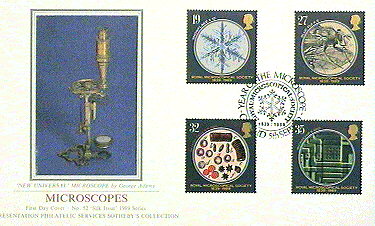
So I hope I've demonstrated that you don't have to be
a dedicated philatelist to enjoy collecting stamps related to a particular
microscopy theme. Reference 1 below illustrates the many themes for which
microscopy is depicted on stamps, and this series of articles may provide
some ideas for your own collection.
Stop press: Coincidentally, just as this article
was published in the June 1997 issue of Micscape, an updated checklist
of microscopes on stamps has been published (see reference 2). This list
as well as being valuable in bringing William Wergin's list up to date,
catalogues them based on the Stanley Gibbon's numbers which is particularly
useful for British collectors.
Dave
Walker ... comments welcomed!
Read a Micscape article discussing and illustrating Photomicrography
on stamps (rather than microscopes) in more detail.
Related web sites:
Microscopy
as illustrated on postage stamps - an excellent online stamp gallery
of various microscopy themes and also of famous scientists, with notes.
References
1) 'Microscopes and Postage Stamps' by William
P. Wergin, Proceedings of the Royal Microscopical Society, 1990, volume
25, pages 115-121, 212-214, 249-253, 324-327,416-422. A series of definitive
articles and coloured plates. The last set of pages is a list of stamps
depicting microscopes up to August 1990. The list includes the country,
date of issue and the Scott catalogue number. Also provides references
to articles published prior to 1990 on similar topics.
2) Microscopes on Stamps: A Checklist to 1996 by
W Heathwood. Quekett Journal of Microscopy, 1997, 38(1), pp37-47. This
invaluable list provides the SG catalogue number, the face value, year
of issue and a brief description of the stamp. Useful guidelines on starting
a collection are also provided in the accompanying article.
3) 'The Royal Microscopical Society Stamps' by
Peter Evennett, Proceedings RMS, 1989, 231-237. A fascinating insight into
the design and production of the stamps issued to celebrate the RMS 150th
anniversary (illustrated on the first day cover above).
4) 'Microscopy Receives the Stamp of Approval'
by A. R. Lane, Microscopy and Analysis, 1989, September, 15-18. An interesting
article on how microscopes are used to monitor the production of stamps
and also provides a good introduction on the types of printing techniques
used.
© Onview.net Ltd, Microscopy-UK, and all contributors 1995 onwards. All rights
reserved. Main site is at www.microscopy-uk.org.uk with full mirror at www.microscopy-uk.net.


 I thought there must be a better way to collect than this, so a trip to
my local university library in late 1990 had me browsing through microscopy
journals to see if anyone had catalogued them. Fortunately, I didn't have
to look far. The Proceedings of the RMS had published a superb series of
articles earlier in 1990 by William Wergin on this very topic. The articles
had a complete list of stamps issued world-wide which depicted a microscope
in some shape or form, and were illustrated by colour plates of many of
these stamps. The colour plates showed the different themes for which a
microscope illustration has been used on stamps. This varies from the celebration
of famous discoveries such as Koch's isolation of the tubercle bacillus,
health topics such as malaria eradication and scientific endeavour.
I thought there must be a better way to collect than this, so a trip to
my local university library in late 1990 had me browsing through microscopy
journals to see if anyone had catalogued them. Fortunately, I didn't have
to look far. The Proceedings of the RMS had published a superb series of
articles earlier in 1990 by William Wergin on this very topic. The articles
had a complete list of stamps issued world-wide which depicted a microscope
in some shape or form, and were illustrated by colour plates of many of
these stamps. The colour plates showed the different themes for which a
microscope illustration has been used on stamps. This varies from the celebration
of famous discoveries such as Koch's isolation of the tubercle bacillus,
health topics such as malaria eradication and scientific endeavour.
 Many of the stamps depicting microscopes used stylised microscopes or the
microscope did not form a good proportion of the illustration. My collection
to date is still very modest, just fifty or so, but when they are nicely
mounted in an album with the first day covers they are an attractive way
of illustrating the history of microscopes and microbiology. Part of the
fun of collecting is tracking down the more elusive stamps. I just regularly
glance through thematic catalogues to see if the ones I'm looking for have
turned up. This is made easier as some of the larger dealers are now putting
their catalogues on-line.
Many of the stamps depicting microscopes used stylised microscopes or the
microscope did not form a good proportion of the illustration. My collection
to date is still very modest, just fifty or so, but when they are nicely
mounted in an album with the first day covers they are an attractive way
of illustrating the history of microscopes and microbiology. Part of the
fun of collecting is tracking down the more elusive stamps. I just regularly
glance through thematic catalogues to see if the ones I'm looking for have
turned up. This is made easier as some of the larger dealers are now putting
their catalogues on-line.
 If you don't fancy collecting all 400 plus of the stamps depicting microscopes
plus the new ones regularly issued, there are various narrower themes that
you may wish to choose. For example, electron microscopes are only infrequently
illustrated on stamps issued to August 1990. Photomicrographs of a specific
topic e.g. protozoa or microbiology are another group of potential interest
although I'm uncertain of the number issued. The image left shows an attractive
photomicrograph of blood cells. The stamp set celebrating the RMS 150th
anniversary also chose a theme of photomicrographs, and there are some
very attractive first day covers including this set of stamps. A typical
one is shown below, the microscope by George Adams is printed on silk.
If you don't fancy collecting all 400 plus of the stamps depicting microscopes
plus the new ones regularly issued, there are various narrower themes that
you may wish to choose. For example, electron microscopes are only infrequently
illustrated on stamps issued to August 1990. Photomicrographs of a specific
topic e.g. protozoa or microbiology are another group of potential interest
although I'm uncertain of the number issued. The image left shows an attractive
photomicrograph of blood cells. The stamp set celebrating the RMS 150th
anniversary also chose a theme of photomicrographs, and there are some
very attractive first day covers including this set of stamps. A typical
one is shown below, the microscope by George Adams is printed on silk.
